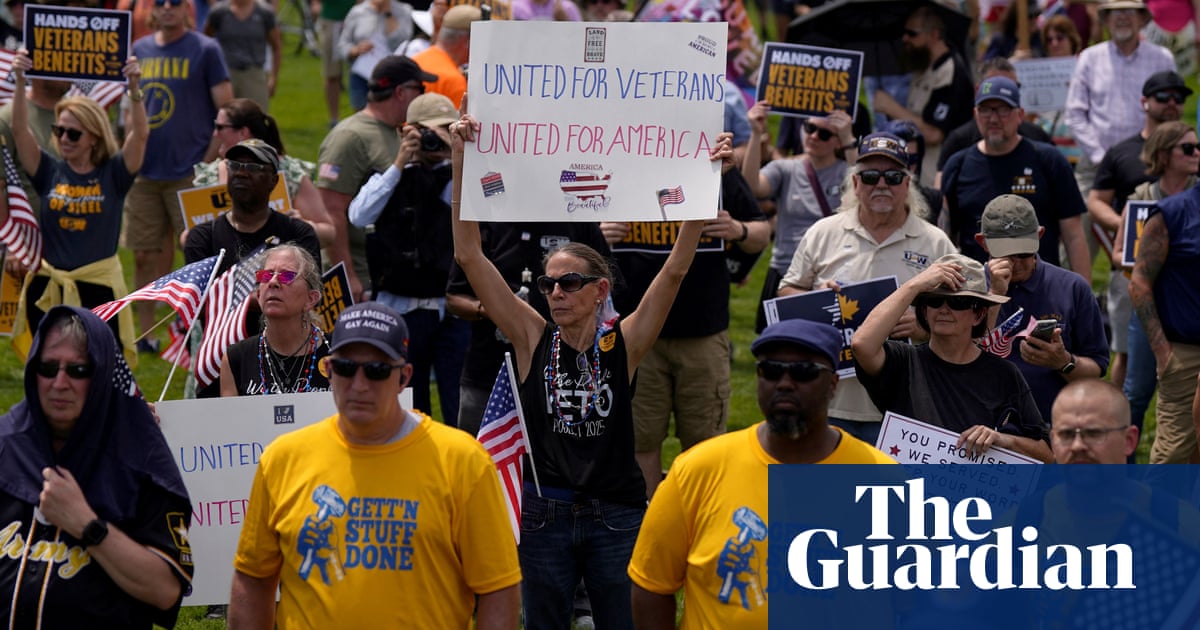A flurry of red, white and blue American flags fluttered across the National Mall on Friday as more than 5,000 military veterans and their allies descended onWashingtonto protest against the planned elimination of 80,000 jobs at the Department of Veterans Affairs (VA) and the cancellation of hundreds of contracts for veterans services with community organizations.
“I hope that in the future veterans will be able to get their benefits,” said David Magnus, a navy veteran who decided to travel from Pittsburgh, Pennsylvania, after his doctor told him she was quitting during a recentmental healthappointment. BeforeDonald Trumpreturned to office in January, “the VA was good”, he said, but since then medical staff have faced harassment that puts the entire system at risk.
“It used to be, you’d call and get an answer,” he said. “Now, so much is going on that they don’t know where to put you.”
Organizers said that in addition to the march in Washington, there were more than 200 corresponding actions across the country, from watch parties to vigils held at VA clinics. Many veterans told the Guardian they came to the nation’s capital on their own after hearing about the rally online.
The VA secretary, Doug Collins, has said the efforts are designed to trim bureaucratic bloat and will have no impact on veterans’ healthcare or benefits.Reporting by the Guardianlast month found the agency, which provides healthcare to more than 9 million veterans, has already been plunged into crisis. Across the nation, appointments have been cancelled, hospital units closed, the physical safety of patients put at risk.
Demonstrators said theTrump administrationis seeking to destroy the VA, the largest integrated healthcare system in the United States, with 170 government-run hospitals and more than 1,000 clinics, and replace it with a private voucher program that will provide substandard care.
“We’re a generation of service. We volunteered and stepped up to lead. Now we are seeing the promises made to us come under attack,” said Kyleanne Hunter, the chief executive of Iraq and Afghanistan Veterans of America and a Marine Corps veteran who flew multiple combat missions as an AH1-W Super Cobra attack pilot.
The administration’sproposed budgetfor the VA, released on Friday, slashes spending for “medical services” by $12bn – or nearly 20% – an amount offset by a corresponding 50% boost in funding for veterans seeking healthcare in the private sector.
“We’re already being starved,” said Sharda Fornnarino, a Navy veteran and one of about three dozen nurses brought to the rally by the National Nurses United union. Fornnarino, who works at the VA in Denver, Colorado, said that while politicians in Washington debate permanent staff reductions, essential healthcare positions are being left vacant.
With fewer staff on the floor, veterans on hospice “are being left to die in their own piss and shit”, said Teshara Felder, a Navy veteran and nurse at the agency’s hospital in Atlanta, Georgia, said.
A blue-ribbon commission established by the agencylast year foundveterans received significantly better care at lower cost from the public system. Private providers operated with little oversight, they wrote, and “are not required to demonstrate competency in diagnosing and treating the complex care needs of veterans nor in understanding military culture, which is often critical to providing quality care for veterans”.
The VA says the budget submission “prioritizes care for our most vulnerable veterans, including those experiencing homelessness or at risk of suicide” and “eliminates nonessential programming and bureaucratic overhead that does not directly serve the veteran”.
The march was held on the 81st anniversary of D-day, when Allied troops stormed the beaches of Normandy, a decisive turn in the war against Nazi Germany during the second world war. Organizers said their inspiration goes back even further – to the “Bonus Army” march on Washington in 1932 during the depths of the Great Depression, when thousands of first world war veterans gathered on the National Mall to demand promised benefits, only to have theUS militarydeployed against them.
Christopher Purdy, an Afghanistan war veteran and organizer of today’s march, said the Bonus Army rally helped set the stage for the New Deal social programs and eventually the GI Bill, which provided higher education, healthcare and home ownership to veterans returning from the second world war.
Other speakers criticized Trump’s decision to impose a travel ban on visitors from 12 countries, including Afghanistan, where many of the demonstrators served alongside translators who risked their lives for the US. Shortly after taking office in January, Trump ordered a pause on the US refugee admissions program, putting translators’ safety in doubt.
“We all left behind people who are now marked,” said Nadim Yousify, who immigrated to the United States in 2015 after working as a US government translator in Afghanistan and later joined the Marine Corps.
